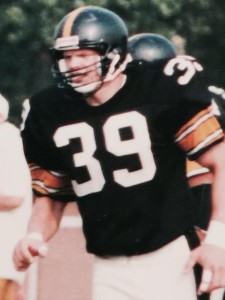Meditations on the Dangers of Modern Football From a Former Pro

Thane Ritchie was a member of the Pittsburgh Steelers and Chicago Bears during two years as part of the NFL.
American football faces a crisis today, even as the NFL remains more popular than ever. With the ever-increasing evidence and incidence of long-term brain damage from contact sports, the future of American football may not resemble its current form. When I think about the game, I am reminded of the Lao-Tzu quote, “If you do not change direction, you may end up where you are heading”. Indeed, wise words that ought to be heeded by those who can change the NFL’s present course.
Harder, Better, Faster, Stronger
When I played tight end for the Steelers and Bears in 1989 and 1990, respectively, the average weight for my position fell somewhere around 235 pounds. In the 1950s you would be hard-pressed to find a lineman that weighed that much. Today’s NFL players continue to get larger and larger. Modern offensive linemen average 310 pounds – a nearly 40-pound increase over average O-line weights in the 1980s. What’s more, they aren’t just heavier than they used to be; they’re faster now, too. When the whistle blows, today’s football player might endure g-forces over 15 times stronger than that of an F-16 fighter jet roll.
A couple years ago, NPR compared two of the hardest-hitting players from vastly different eras of pro football. When the 190-pound defensive lineman Red Badgro hit you at full speed in 1930, the New York Giant took you down with approximately 970 pounds of force. Today, 335-pound Ravens defensive tackle Haloti Ngata, who also runs the 40-yard-dash in less than five seconds, can deliver 1,700 pounds of force at top speed. So what does this mean? If spread evenly across the body, it’s the difference between a very hard hit and an extremely hard hit. The differences become profound, however, when you examine how that force can be concentrated today. Today’s “bigger, faster, stronger” athletes play on a football field that is increasingly more vicious and more dangerous.
Paved With Good Intentions
Anyone familiar with football of the ‘30s can picture the padded leather helmets that make yesterday’s heroes of the gridiron look at best, foolish, and at worst, like they must have a death wish. But not only were the physics of the hits back then “softer” than they are now, the head was never, ever, used as a weapon. If nothing else, the lack of protection to the head and face led to greater care and awareness of these vital body parts. Shoulder and arm tackles were the standard way to bring a man down.
In pursuit of advanced protection, the plastic football helmet debuted in the 1940s and underwent substantial development over the subsequent decades. By the 1980s, polycarbonate alloy became plastic de rigeur for helmets from Pop Warner to the pros. Keeping pace with the enhanced safety of these space-age head protectors, bold, innovative techniques for their use were introduced to the sport. Unfortunately, these tactics trended toward offensive, rather than defensive, strategies.
Hitting Them Where It Used to Hurt
With the advent of stronger and safer helmets came a tendency to turn them, and the contents inside, into blunt-force weapons on the field. Despite efforts to penalize “spearing” at the college level in the 1970s and in the NFL in the 1980s, the official rules surrounding the practice frequently suffered from confusing and contradictory language that made them difficult to enforce. More often than not, players, coaches and officials deliberately ignored the rules over objections from athletic trainers and specialists in sports medicine.
When combined with the increasing size and speed of NFL players in the modern era, spearing transformed from a risky practice into something that would unquestionably destroy the brain in time. Today, harsh penalties come with many types of helmet tackles, including spearing, but they still happen in the normal course of play.
This Is (Possibly) the End
By now, most people have heard about the alarming new studies on permanent damage from repeated concussions and similar head injuries in contact sports, whether in football, rugby, hockey, wrestling, or boxing. And while “punch-drunk” might not be a new term, chronic traumatic encephalopathy (CTE) is.
This degenerative disease is only detectable in a post-mortem analysis of the brain, but autopsies following the recent suicides of Jovan Belcher, Junior Seau, and my former Bears teammate, Dave Duerson, have confirmed that they all suffered from CTE-related dementia. Former players have already filed a series of lawsuits against the NFL for negligence of concussion-related injuries sustained on the job, with many more likely to come. As a result, prospective Hall-of-Famers or, at least, veteran players are opting for early retirement, from just a couple years into their careers or before they even suit up for their first game in the pros. After all, fame and money can buy many things, but not new brains.
So how do we resolve the issue and keep the sport I love from disappearing forever? As traumatic brain injuries in football become more frequent, the game may be forced to change. A little league football coach in the Chicago area recently told me that participation in his program has dropped by nearly 50 percent in just three years. With this downward trend in youth football, America’s most popular spectator sport may eventually go the way of boxing, our nation’s former favorite spectator sport. The NFL must find a way to change voluntarily or embrace both the mounting legal consequences of its inaction and the ongoing PR nightmare that won’t end any time soon.
Thane Ritchie played football at Duke University and Wheaton College (Illinois), where he was later inducted into the Hall of Fame. He went on to play tight end for the Pittsburgh Steelers and Chicago Bears before beginning a career in alternative asset management. Visit thaneritchie.com for more about Thane and his work.










